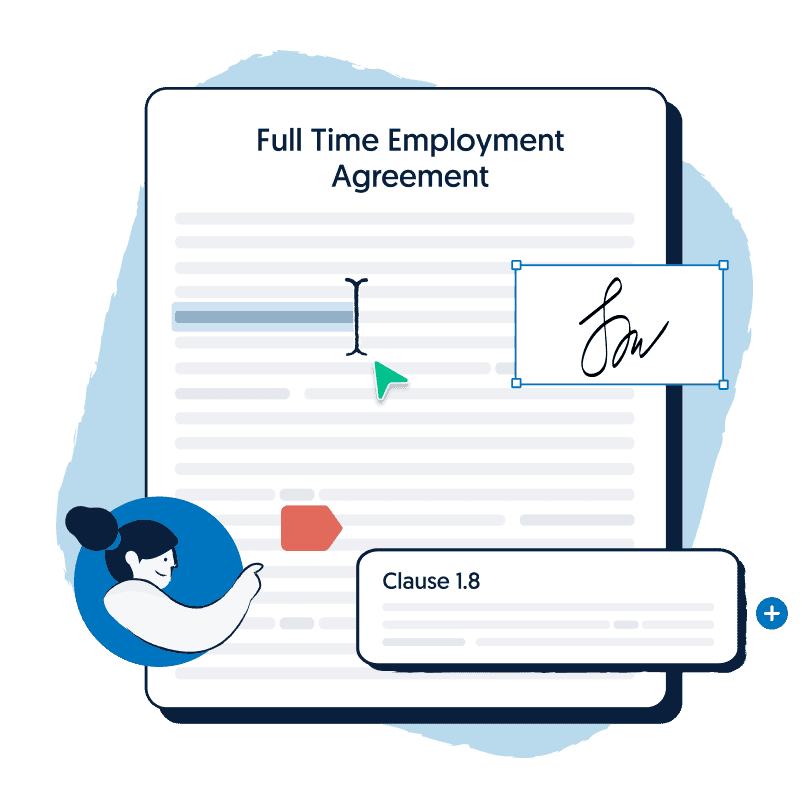Whether you are a small business owner or a company chances are at some point you’d like to hire more employees to help support your growing business.
And while it’s exciting, the big question (and a confusing one at that) is whether or not you should hire casual employees or offer full-time employment to people?
So what are the differences between casual and full-time employees, you ask?
On the surface, they may seem similar but casual and full-time employees have different work hours, leave policies, pay, public holidays, notice periods, and other benefits.
As an Australian business, you must understand what employment type will work best for your business, on what basis you should hire someone and ultimately what rights you have as an employee.
We break down the differences for you and more in this post so that you can take an informed decision.
Read along
What is Casual Employment?
Let’s begin with what a casual employee and casual work is. Under the Fair Work Act, a person is a casual employee if they accept an offer for a job from your business, knowing that there is no firm commitment for ongoing work or guaranteed hours of work.
In other words, think of a casual employee as someone who works on an ad hoc basis with irregular and unpredictable hours.
For example, if you hire a casual employee, you can change their roster weekly to suit your business’s needs, but this also means that they can also refuse to accept work or swap shifts. However, if you wish to provide your casual employee regular hours, such as every Monday or Wednesday, you have the option to do so.
Casual employees also don’t get paid days off, notice of termination (unless it’s written in their employment contract), or redundancy pay even if they work regularly for a long time.
So to summarise, a person is a casual employee if:
- A casual employee accepts a job in your business with the understanding that there is no firm commitment for regular employment and advancement;
- Your employee will work indefinitely with an agreed pattern of work;
- The casual employee will typically work less than full-time hours;
- Casual employees don’t receive paid days off;
- Casual employees will not receive a notice of termination unless it’s been stated in their employment contract; and
- Casual employees don’t receive redundancy pay.
Just like full-time employees, casual workers are also eligible for some entitlements. Not a lot of employers know this when they hire a casual employee.
Under the National Employment Standards (the NES), casual employees are entitled to:
- An opportunity to become a permanent employee;
- 2 days unpaid carer’s leave;
- 2 days unpaid compassionate leave per occasion;
- 5 days unpaid family and domestic violence leave (in a 12-month period);
- unpaid community service leave;
- Casual loading- this is a higher rate than what full-time workers receive because casual workers don’t get benefits such as sick leave or annual leave. This is generally 15 – 25% of the hourly rate in addition to the hourly rate;
- Casual Employment Information Statement; and
- Casual conversion (For long-term casual employees)- If a casual employee has been with your business for at least 12 months (or 6 months in some awards) and during those 12 months has worked systematic hours without any significant changes, they can request to convert to a full-time or part-time employee. However, you may refuse this request on reasonable grounds (e.g. business is slow).
Casual employees can also request flexible working arrangements and take unpaid parental leave if
- you have employed the casual worker regularly for over 12 months; and
- The casual worker can reasonably expect to continue being employed by you regularly.
Should you decide to hire a casual employee, keep in mind that casual employees can usually terminate their employment with your business without giving you any notice. This is unless their employment contract requires notice.
Don't know where to start?
Contact us on 1800 529 728 to learn more about customising legal documents, obtaining a fixed-fee quote from our network of 600+ expert lawyers or to get answers to your legal questions.
Advantages of Casual Employees
If you’re still not too sure about whether to hire a casual employee, here are some benefits:
- Casual employment is extremely flexible, allowing you to adjust staffing levels according to your business’s needs;
- Employing casual workers provides administrative convenience since there is less; payroll paperwork and fewer chances of unfair dismissal claims if a worker is irregular
- They do not need to accrue leave entitlements such as annual leave, personal/carer’s leave;
- You do not need to provide casual employees with notice of termination or redundancy pay; and
- It will give you the chance to assess the individual’s suitability for a position in your business before offering a full-time or part-time role.
Disadvantages of Casual Employees
No business wants to fear the unknown, so here is a list of disadvantages of hiring casual employees before you make your decision:
- Unlike part-time work and full-time employees, casual employees will be more costly as you will need to pay the casual loading;
- As a result of the irregular hours of work, casual employees can notify at short notice that they are unable to work;
- They can be unavailable for work more regularly than full-time or part-time employees;
- Casuals can resign without notice unless you have a specific term in their employment contract; and
- Long term casuals would be entitled to long service leave at the casual rate of pay.
Now that you have a pretty good understanding of casual employment, let’s move to full-time employees.
What is Full-time Employment?
We’re sure most of your business is made of full-time employees, but let’s just have a closer look at who a full-time employee actually is.
A full-time employee has ongoing employment and works, on average, around 38 hours each week. The actual hours of work for a full-time employee will usually depend on the particular business and will depend on what is agreed between an employer, you, and your employee.
The hours will either be set out in their employment agreement or your particular industry award.
Another key aspect of full-time employment is that employees can either be permanent employees or have a fixed-term contract.
A permanent full-time employee is someone who works the ordinary hours, usually 38 hours per week defined by the award or employment agreement you set up for the employee covering the work they will be completing. Ordinary hours usually mean regular and ongoing work.
On the other hand, full-time fixed-term employment is different to permanent employment because individuals are employed on an ongoing basis until either you or the employee you’ve hired decides the end of the working relationship.
Unlike casual employment, if a full-time employee wishes to leave your business, they must provide you with a notice of termination period. This is generally 4 weeks for full-time employees. However, the duration of notice will usually depend on how long the employee has been with your business and what was originally set out in their employment contract.
Here is a summary of the main elements of full-time employment:
- Full-time employees generally work a maximum of 38 hours per week
- They can be permanent employees or on fixed-term contracts.
- The termination of full-time employment requires a notice period
Full-Time Employee Entitlements
Unlike a casual employee, a full-time employee has many more entitlements. NES is short for National Employment Standards, and as its name suggests are minimum employment standards for full-time employees. They are:
- Maximum weekly hours – you can’t request your full-time employee to work more than 38 hours per week. However in reasonable circumstances, you may ask your employee to work some additional hours;
- Flexible working arrangements – If your employee has worked for you for at least 12 months, they can request flexible working arrangements such as changes to work hours, work patterns or locations (e.g. working from home);
- Parental entitlements – These entitlements include: maternity leave, paternity leave and partner leave, adoption leave and special maternity leave;
- Annual leave – Entitled to 4 weeks annual leave;
- Personal leave and carer’s leave – This is also known as sick leave and refers to 10 days of leave available to full-time employees who are ill or must care for an ill family member not on a pro-rata basis;
- Compassionate leave – Available for 2 days and is commonly taken when your employees family member dies or develops a serious illness or condition;
- Unpaid family and domestic violence leave – 5 days if your employee is experiencing violence at the hands of a close relative;
- Community service leave – Only available for voluntary community activities such as jury duty. If the activity is some activity other than jury duty, the leave is generally unpaid;
- Long service leave – Long service leave is the amount of leave that an employee accrues from having worked for the same employer for a sufficient period of time;
- Public Holidays – A full-time employee is entitled to receive time off work on public holidays;
- Notice of termination and redundancy pay – Both you and your full-time employee need to each other notice of termination; and
- Fair Work Information Statement– You must give every new employee a copy of the Fair Work Information Statement (the FWIS) before, or as soon as possible after, they start their new job.
It’s important to remember that you cannot contract out of the entitlements listed. Your employee’s contract can provide for additional entitlements but not less than the NES.
Advantages of Full-time Employees
Hiring a full-time employee comes with a magnitude of benefits. Want to know what they are? Have a look at the list below:
- It is common for full-time employees to feel proud of their position in your business.
- Being part of a team and working somewhere they feel comfortable and secure gives them satisfaction.
- The hourly wage for an employee is much less than that of the part-time and casual workers
- Higher rates of productivity, consistency with your workloads and a stronger level of employee loyalty
- Easy payroll- full-time employees have fixed salaries and are paid weekly or biweekly or monthly.
- Individuals looking for full-time employment are often looking to stay with the business for a long period of time
Disadvantages of Full-time Employees
As with any employment type, hiring full-time employees has some disadvantages. Here are a few things to look out for if you choose to hire a full-time employee:
- Full-time employees have more entitlements compared to casual employees e.g. annual leave, sick leave, maternity leave etc.
- Your business will always need to pay salaries, even during quiet periods in your business
- You will be responsible for your employee’s training and professional development
What are the Key Differences between Casual and Full-Time Employees
1. Leave Entitlements
| Full-Time Employee | Casual Employee |
| A full-time employee is entitled to all the NES leave entitlements. This includes annual leave, sick leave and carers leave. | Casual employees do not receive any paid leave. |
2. Working Hours
| Full-Time Employee | Casual Employee |
| Full-time employees generally work a maximum of 38 hours per week, plus reasonable additional hours. They can be permanent employees or on fixed-term contracts. | Casual employees do not have any guaranteed working hours. Their workings hours will be unpredictable and irregular. |
3. Public Holiday
| Full-Time Employee | Casual Employee |
| If a full-time employee’s usual working day falls on a public holiday, they must be paid for the public holiday. If they don’t usually work on the public holiday, they are not entitled to public holiday pay. For example, on a Saturday or Sunday. | Casual employees do not get any public holiday payments. |
4. Pay
| Full-Time Employee | Casual Employee |
| A full-time employee’s pay is usually based on an annual salary outlined in the modern award or their employment agreement. | A casual employees pay is based on an hourly rate of pay with a casual loading under a specific award or their employment agreement. |
5. Superannuation
There are no differences in superannuation.
| Full-Time Employee | Casual Employee |
| Full-time employees are entitled to 9.5% of their ordinary earnings (does not include overtime payments). | A casual employee is entitled to 9.5% of the value of their ordinary time earnings. |
6. Notice Period
| Full-Time Employee | Casual Employee |
| A full-time employees notice period is typically set out in a modern award or their employee agreement. The notice period is usually 4 weeks but you can choose to alter this initially in your employee’s contract. A part-time employee is also entitled to written notice or payment if you wish to terminate their employment. | There is no notice period. Unless your employee’s agreement or award specifies a different notice period. |
Full-time and casual employment contracts differ in many ways, just as part-time and casual employment agreements do. Learn more here.
Conclusion
Knowing the differences between casual employees and full-time employees can help you ensure that you’re hiring the right person for your business’s needs (while staying on the right side of the law!)
There’s always room to hire a wide range of employees but determining the status of an employee in the first instance can sometimes be very tricky.
Misunderstanding your obligations as an employer to your casual or full-time employee can put you at risk of some penalties from the Fair Work Ombudsman. I’m sure you, like many businesses, don’t want that.
It is important that you understand the role you want your employee to play in your business and so if you need a hand why not use our full-time or casual employment agreements to hire your next employee the right way.







